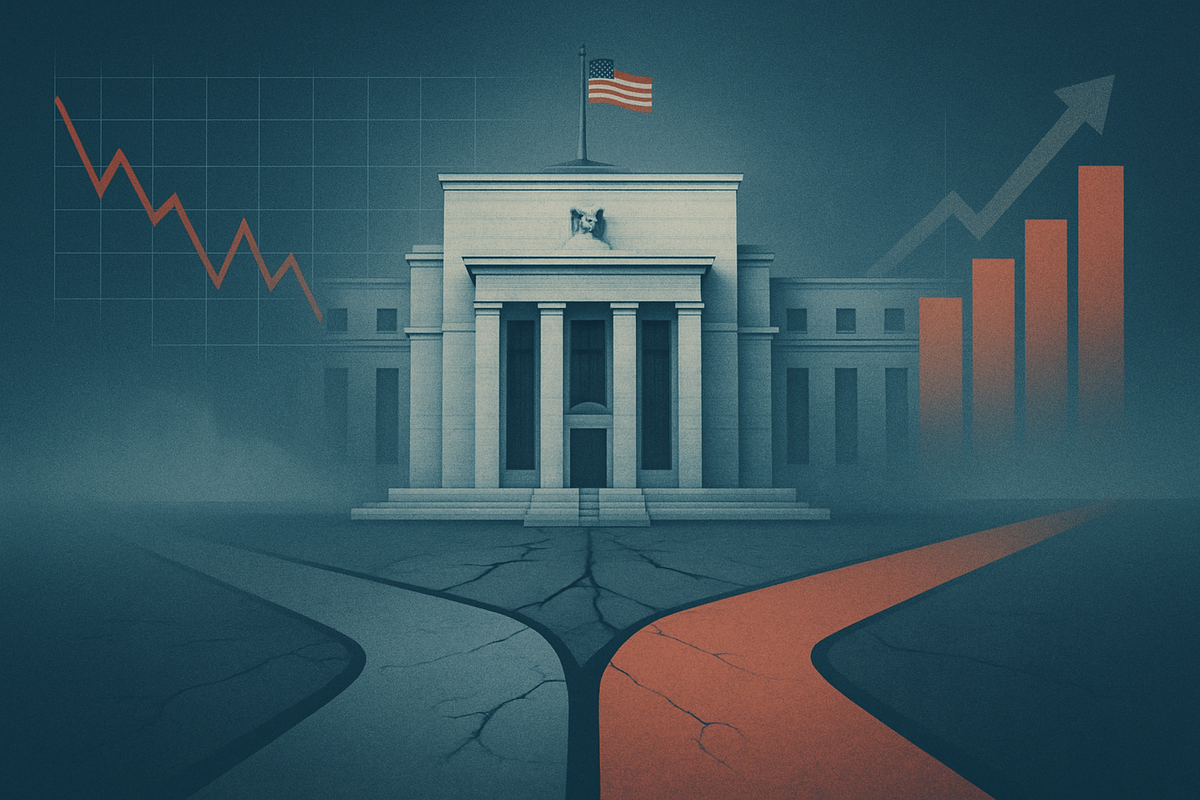Financial News
Federal Reserve's Internal Strife Casts Shadow Over December Rate Cut Hopes

Sharp disagreements among Federal Reserve officials regarding the direction of the economy are significantly jeopardizing the likelihood of an interest rate cut next month, specifically in December 2025. This internal discord within the Federal Open Market Committee (FOMC) has injected substantial uncertainty into financial markets, causing a notable recalibration of investor expectations and directly impacting borrowing costs for businesses and consumers alike. What was once considered a near certainty for a rate reduction has now become a contentious debate, leaving the market in a state of heightened volatility and anticipation.
The immediate implication of this deep division is a palpable shift in market sentiment. Bond futures traders, who just a month ago were pricing in a 95% chance of a December rate cut, have seen those odds plummet to as low as 40-53% by mid-November 2025. This dramatic adjustment signals that the "higher-for-longer" interest rate narrative might persist, leading to elevated borrowing costs for everything from mortgages and auto loans to business expansion. Consumers, already grappling with a high cost of living, face the prospect of continued financial strain, while interest-sensitive sectors brace for prolonged headwinds.
Deep Divisions Threaten Monetary Policy Consensus
The core of the Federal Reserve's current predicament stems from a fundamental divergence in economic outlooks among its key policymakers. This internal struggle, which has intensified in recent weeks, centers on balancing the Fed's dual mandate of achieving maximum employment and maintaining price stability. One faction, often characterized as "hawks," remains primarily concerned with persistent inflation, which continues to hover above the Fed's 2% target. They argue that despite some economic cooling, the underlying strength of the economy can withstand current interest rate levels, and premature cuts could reignite inflationary pressures.
Conversely, a "dovish" camp within the FOMC is increasingly alarmed by nascent signs of a weakening labor market, including meager hiring figures and a potential slowdown in economic activity. This group advocates for proactive interest rate cuts to prevent a more significant economic downturn or widespread job losses. The intensity of these disagreements is so pronounced that analysts are predicting an unusually high number of dissenting votes—potentially four or five—at the upcoming December 9-10 FOMC meeting, a level of internal dissent not witnessed since 1992.
Adding to this policy paralysis is a critical "data vacuum" caused by a recent 43-day government shutdown. This shutdown has delayed or, in some cases, entirely eliminated crucial economic reports on inflation, employment, and other vital indicators. Without comprehensive, up-to-date information, policymakers are forced to rely on incomplete or privately sourced data, further entrenching their pre-existing viewpoints and making consensus-building exceedingly difficult. This lack of clear data has transformed the policy debate into a more speculative and ideologically driven discussion, rather than a data-dependent one. Initial market reactions have been swift and pronounced: the U.S. dollar has seen some short-term upside as rate cut expectations diminish, while Treasuries have rallied amid a selloff in equities and signs of labor market fragility, reflecting investor uncertainty and a flight to safety.
Sectoral Winners and Losers in a Divided Rate Environment
The Federal Reserve's ongoing internal conflict over interest rates creates a clear demarcation between potential winners and losers across various economic sectors. Companies highly sensitive to borrowing costs will bear the brunt of prolonged uncertainty or a "higher-for-longer" rate environment, while others might find unexpected advantages.
Potential Losers:
- Real Estate and Construction: This sector is arguably the most vulnerable. Elevated mortgage rates, a direct consequence of higher Fed rates, will continue to dampen housing demand and affordability. Builders like D.R. Horton (NYSE: DHI) and Lennar Corporation (NYSE: LEN) could see slower sales and reduced profit margins due to higher financing costs for their projects and potential buyers. Real Estate Investment Trusts (REITs) such as Simon Property Group (NYSE: SPG), which rely heavily on debt financing for acquisitions and operations, will face significantly increased interest expenses, eroding their profitability and potentially impacting dividend payouts.
- Automotive Industry: Large purchases like vehicles are often financed. Companies like General Motors (NYSE: GM) and Ford Motor Company (NYSE: F) could experience a slowdown in sales as higher auto loan rates deter consumers, particularly for new car purchases.
- Growth Stocks and Technology: Many technology companies, especially those in their growth phase, rely on readily available and inexpensive capital to fund expansion, research, and development. A higher interest rate environment makes future earnings less valuable in present terms and increases the cost of capital, potentially hindering the growth prospects of companies like Snowflake (NYSE: SNOW) or Palantir Technologies (NYSE: PLTR), which may not yet be consistently profitable.
- Highly Leveraged Companies: Businesses with substantial outstanding debt will see their interest payment burdens increase if rates remain high or rise further. This can strain cash flows and reduce funds available for investment or shareholder returns.
Potential Winners (or those less impacted):
- Banks and Financial Institutions: In a "higher-for-longer" scenario, banks like JPMorgan Chase (NYSE: JPM) and Bank of America (NYSE: BAC) can often benefit from wider net interest margins (NIM), the difference between the interest they earn on loans and what they pay on deposits. While loan demand might soften, the profitability on existing loans could improve.
- Value Stocks and Dividend Payers: Companies with strong balance sheets, consistent profitability, and stable cash flows, often found in mature industries, tend to perform relatively better during periods of economic uncertainty and higher rates. Their dividends become more attractive compared to fixed-income alternatives.
- Energy and Commodities: These sectors can be less directly impacted by domestic interest rates and more influenced by global supply-demand dynamics and geopolitical events. Companies like ExxonMobil (NYSE: XOM) or Chevron (NYSE: CVX) might see their performance driven by commodity prices rather than U.S. monetary policy.
- Consumer Staples: Companies providing essential goods and services, such as Procter & Gamble (NYSE: PG) or Walmart (NYSE: WMT), tend to be more resilient as consumer demand for their products remains relatively stable regardless of interest rate fluctuations.
Broader Economic Implications and Historical Context
The Federal Reserve's current policy impasse extends beyond immediate market reactions, carrying significant wider implications for the broader economy and setting potential precedents for future monetary policy. This deep division among officials fits into a broader trend of increased complexity in economic policymaking, where traditional indicators often send conflicting signals, making a clear path forward elusive. The ongoing debate over whether inflation is truly tamed or merely suppressed, versus the potential for a weakening labor market, highlights the difficulty in navigating a post-pandemic economy characterized by supply chain disruptions, geopolitical tensions, and shifting consumer behaviors.
The ripple effects of this uncertainty are far-reaching. Competitors and partners across various industries face an unpredictable economic landscape, making long-term planning and investment decisions challenging. For instance, businesses contemplating expansion or capital expenditures might delay projects, leading to a slowdown in economic growth. Regulatory bodies might also face pressure to adapt. If the economy slows significantly due to prolonged high rates, calls for fiscal stimulus or other governmental interventions could intensify, potentially leading to a clash between monetary and fiscal policies.
Historically, periods of significant Federal Reserve disagreement have often coincided with critical junctures in the economy. For example, during the early 1990s, the Fed grappled with how to respond to a recession and a nascent recovery, leading to internal debates that ultimately shaped the course of monetary policy. Similarly, during the Great Financial Crisis, the initial responses saw considerable debate over the appropriate tools and timing of intervention. The current situation, however, is unique in that the disagreement is occurring before a clear crisis, primarily over the prevention of future economic imbalances, whether it be persistent inflation or a recession. This situation underscores the challenge of proactive policymaking in an environment where the "neutral" rate of interest is itself a subject of debate, and the impact of past tightening cycles is still fully unfolding. The absence of reliable data due to the government shutdown further exacerbates this challenge, pushing policymakers to rely more on their individual economic philosophies than on a unified data-driven consensus.
The Path Forward: Scenarios and Strategic Adjustments
The immediate future for the Federal Reserve and financial markets is fraught with uncertainty, presenting a range of short-term and long-term possibilities. In the short term, the most critical event is the upcoming December 9-10 FOMC meeting. The outcome could range from a highly contentious "no cut" decision, potentially accompanied by multiple dissents, to a very narrowly approved, smaller-than-expected rate cut. A "no cut" scenario would likely lead to continued market volatility, particularly in interest-sensitive sectors, as investors digest the implications of a prolonged "higher-for-longer" policy stance.
Looking further ahead into 2026, several scenarios could unfold. One possibility is that the Fed maintains its current stance for several more months, waiting for clearer economic data to emerge post-shutdown. This "wait and see" approach could alleviate some internal disagreements but would prolong market uncertainty. Another scenario involves a delayed rate-cutting cycle, where the first cut occurs in early 2026, but at a slower pace than previously anticipated. Conversely, if economic data deteriorates rapidly—particularly in the labor market—the dovish faction could gain sway, leading to more aggressive cuts than currently priced in, though this seems less likely given the current inflationary concerns.
Businesses and investors will need to make strategic pivots to adapt to this evolving landscape. Companies with significant debt loads should prioritize deleveraging or refinancing at favorable rates if opportunities arise. Growth-oriented firms may need to re-evaluate their capital expenditure plans, focusing on projects with quicker returns and lower capital intensity. For investors, this period calls for a careful re-evaluation of portfolios, emphasizing companies with strong balance sheets, stable cash flows, and resilience to higher borrowing costs. Opportunities may emerge in value stocks or sectors less sensitive to interest rate fluctuations. The market will closely watch for any shifts in official rhetoric, new economic data releases (once the data vacuum is resolved), and, crucially, the voting patterns and dissenting opinions at future FOMC meetings, as these will signal the prevailing sentiment within the Fed.
Conclusion: Navigating a Period of Unprecedented Fed Uncertainty
The current deep disagreements within the Federal Reserve over the future of interest rates represent a pivotal moment for the U.S. economy and global financial markets. The immediate takeaway is clear: the once-anticipated December 2025 interest rate cut is now highly uncertain, leading to increased market volatility and a recalibration of borrowing cost expectations. This internal strife, exacerbated by a critical lack of timely economic data due to a government shutdown, underscores the immense challenge of navigating a complex post-pandemic economic environment.
Moving forward, the market will remain highly sensitive to every utterance from Fed officials and any new economic data that emerges. Investors should brace for continued fluctuations, particularly in sectors highly sensitive to interest rates, such as real estate (e.g., D.R. Horton (NYSE: DHI)) and technology (e.g., Snowflake (NYSE: SNOW)). Conversely, financial institutions (e.g., JPMorgan Chase (NYSE: JPM)) and defensive sectors may offer relative stability. The overarching significance of this period lies in its potential to redefine the Fed's approach to monetary policy in an era of conflicting economic signals, moving away from a clear consensus towards a more contentious, data-dependent, and perhaps slower decision-making process.
What investors should watch for in the coming months includes the precise language used in FOMC statements, the number and identity of dissenting voters at upcoming meetings, and the eventual release of comprehensive economic data, which will finally provide a clearer picture of inflation and employment trends. The trajectory of inflation, the resilience of the labor market, and the overall pace of economic growth will be crucial determinants of whether the Fed eventually moves towards easing, holds steady, or even considers further tightening, making careful monitoring of these indicators paramount for informed investment decisions.
This content is intended for informational purposes only and is not financial advice
More News
View More




Recent Quotes
View More
Quotes delayed at least 20 minutes.
By accessing this page, you agree to the Privacy Policy and Terms Of Service.



